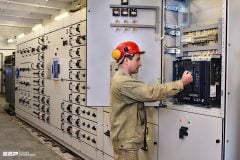Type, routine and special tests
Generally speaking, acceptance tests and final inspections of a transformer should not have any improvisations, but they usually do have. The essential purpose in carrying out the final tests on the transformer is to ensure that the design is as intended about type testing and that the quality of manufacture is consistent with the design in terms of type testing.

The purchase specification should detail all tests that are required to be carried out on the specific transformer. The requirements for testing transformers are described in the international standards.
IEC 60076-1 breaks factory acceptance tests into three categories:
Type tests: tests carried out on the first unit of a design and intended to prove the design,
Routine tests: tests carried out on every transformer and
Special tests: additional tests specified by the Purchaser. Purchasers should note that tests defined as type or special tests at some voltages may well be routine tests at another.
Suppose a transformer has been specified for use in a non-conventional or otherwise special application, or it is to be subject to unusual operating conditions. In that case, the procedure and sequence of tests must be previously specified by the purchaser.
Initial acceptance inspection, testing and start-up procedures are probably the most critical. The initial inspections, both internal and external, should reveal any missing parts or items that were damaged in transit; they should also verify that the transformer is constructed exactly as specified.
The acceptance tests should reveal any manufacturing defects, indicate any internal deficiencies, and establish baseline data for future testing.
This technical article intends to present the practical reasoning behind the procedures recommended by the manufacturer. In some cases, the following guidelines will exceed the manufacturer’s recommendations, and in others, the manufacturer will call for more involved and comprehensive procedures.
- Test procedure
- Standards and testing specifications
- Testing environment
- Measurement accuracy
- Tolerances
- Summary of tests:
- Test sequence
- Test results and test reports
- Site acceptance tests / Erection tests
- Transformer energization
- Trial operation
- Special tests
- Site test reports
- Relevant Standards (PDF)
1. Test procedure
The transformer manufacturers MUST have a test procedure describing all routine and type tests and final inspections. The test procedure should be submitted to the purchaser for approval before manufacture commences.
The factory acceptance tests may/should be witnessed by the purchaser or his representative. The purchaser should be notified in writing in a reasonable time period before the start of any test. We can see nowadays that some manufacturers offer virtual factory acceptance tests, without the actual presence of the purchaser.
Type test evidence obtained on an identical transformer may be offered to the purchaser for consideration instead of further type tests, providing the evidence is not more than five years old and is submitted at the time of tender. Otherwise, type tests should be made.
Routine test and type test evidence for transformer components, for example, bushings and tap changers should be provided by the manufacturer prior to the transformer tests and final inspections.
Figure 1 – Preparing transformer for bushings testing


Go back to the Contents Table ↑
2. Standards and testing specifications
Factory acceptance tests MUST be performed in accordance with recognized standards. Bushings for instance should be tested in accordance with IEC 60137 and on-load tap changers in accordance with IEC 60076-1, IEC 60214-1, and IEC 60214-2, in the absence of any other standards being specified.
Mentioned standards can be downloaded in the last section of this article.










